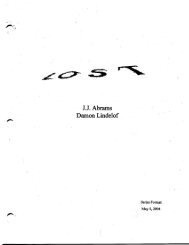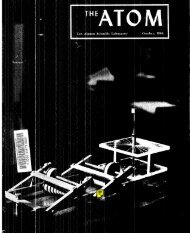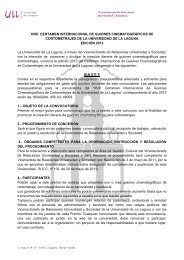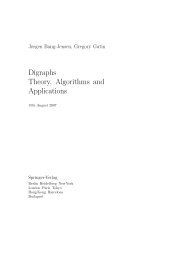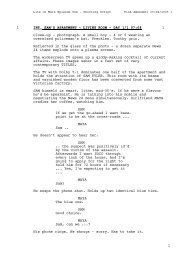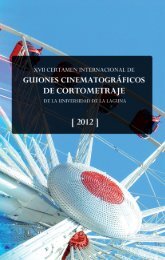You also want an ePaper? Increase the reach of your titles
YUMPU automatically turns print PDFs into web optimized ePapers that Google loves.
.....00000<br />
.....00132<br />
. . . ..99868<br />
Figure 3 Figure 4<br />
ecluation x2 = x has exactly four solution in supernumbers:<br />
0, 1, X andY.<br />
And that's the result we've been waiting for.<br />
llow is fialRossible?<br />
If the operations on supernumbers obey the usual<br />
rules, the usual proof of the f.act that the equation<br />
* - x = 0 has two solutions must work equally well<br />
with supernumbers. Let's see if they really do. As before,<br />
* - x = x(x - l)-there's nothing to rule out this<br />
f.actorization. Therefore ,ilf.* -x:<br />
......052s<br />
x......9376<br />
......3750<br />
......437s<br />
...... 1875<br />
.....5525<br />
0000<br />
0, then eitherx = 0 or<br />
x- 1 = 0. But why? How do we know that the product<br />
ab of supernumbers a andb is zero only if one of them<br />
is zero? In (act, that's wrong! We know perfectly well<br />
that XY: 0!<br />
Indeed, xo is divisible by 5k and yo is divisible by 2k,<br />
so the productxT,)zp is divisible by lOk- that is, it ends<br />
in k zeros. So multiplying X and Y digit by digit, we'll<br />
get only zeros in the result. To dissolve any possible<br />
doubts you may have, look at frgure 4.<br />
If a+0,b+O,butab:0, thena andb arecalledzero<br />
divisors. There are no zero divisors among ordinary<br />
numbers, but we can find them among supernumbers-and<br />
that's the gist of the matter.<br />
By the wa, now we can verify once again that X andY<br />
satisfy our equation: since X + Y = 1 (rememb et, xp+ /p:<br />
10ft + 1- see exercise l), X(X - 1 ) = -X( 1 - Xl : -XY : O,<br />
and, similarly, -Y(Y - 1) : 0.<br />
The equation P=I<br />
Ifx2 :x, then# :* - x : X. x =* = x, * : * . X : X<br />
. x: *: & andso on: x5 = x, * = x,... . So ourfour<br />
solutions to * : x satisfy xm = x for arry m. But does<br />
the equation xm = x have any other roots?<br />
Let's startwith m = 3. Besides 0, I, X, and I the<br />
equation # = x has a solution X - Y:<br />
lx - Yl3 : vz - Y - \xY(x - Yl = x - Y,<br />
because XY = O, alternatively, we could prove that<br />
(X -Ylz = l, which also implies lX -Yl3 = X -Y.In addition,<br />
we can reverse the sign of any root of the equation<br />
# : x and this will yield four other solutions: -1,<br />
-X, -Y, Y - X. A11 in all, we've found nine solutions:<br />
0, 1, -1, X, -X, Y, -Y, X - Y, Y - X.<br />
Exercise 2. Prove that the equation f = x has no<br />
other solutions.<br />
The case m: 4 (and in general the case of any even<br />
m-see the theorem below) is not as interesting.<br />
Exercise 3. Prove that the equations * = x andl2:<br />
x have the same solutions.<br />
In the case m = 5 new solutions emerge. To describe<br />
them, it will suffice to display one of them. Consider a<br />
sequence zo in which 1= 2 and any term zo consists of<br />
the last k digits of zf _ r:<br />
zt : 2, zr: 32, z, : 432, ... .<br />
Exercise 4. Prove that zo is obtained from zo_rby<br />
adding one digit on the left, and that zf - zo is divisible<br />
by 10ft for all k.<br />
The numbers zo define the supernumber<br />
z = ...9879t85432.<br />
Exercise 5. The equationxs -xhas fifteen solutions:<br />
the nine solutions of # - x (see exercise 2) and the<br />
supernumbers Z, -2, X - Z, Z - X, X + Z, -X - Z.<br />
For greater values of m new solutions don't appear.<br />
The reader may try to prove the following theorem.<br />
THronil,{. If m is even, the equation xm : x has the<br />
same solutions (in supernumbers) as x2 = x. If m has<br />
the form 4n - 1 , this equation has the same solutions<br />
as # - x. And if m: 4n + 1, then xm : x has the same<br />
solutionsasx5-x.<br />
Here is one more statement conceming the equation<br />
x- : l:If m is odd, thenx- : t has only one solutionx: 1.<br />
If m is even but not divisibleby 4, then xm = I has four<br />
solutions: l, -1, X - Y, Y - X. If m is a multiple of four,<br />
then xm = I has eight solutions: 1, -1, X - Y, Y - X, X - Z,<br />
Z-X,X+2,-X-2.<br />
fuo mol,e eqtlatiolr$<br />
Exercise 6. For what (ordinary) numbers m does the<br />
equation mx : I have a solution in supernumbers?<br />
(That is, what ordinary fractions can be found among<br />
supernumbers?)<br />
Exercise 7. Is the statement of Fermat's Last Theorerrl-"If<br />
n is an (ordinary) integer greater than 2, then<br />
the equatiort xn + yn : zn has no roots"-true for<br />
supernumbers x, y, z7<br />
Conclusion<br />
If the notion of supernumbers rang a bell for you,<br />
don't be surprised. They are known to mathematicians<br />
as "integer lO-adic numbers." A11 the troubles-or, to<br />
put it more positively, surprises-that we've encountered<br />
are due to the fact that 10 is a composite number.<br />
If we had consideredp-adic numbers with a prime<br />
p (which are defined the same way except that we'd<br />
have to write them using the number system with the<br />
base p), our equation * = x would have had two solutions,<br />
as it should. Actually, if our number system had<br />
a prime base, we wouldn't have had enough material<br />
foi an article like this.<br />
O<br />
OUAilTU[I/IIAIURI I O



